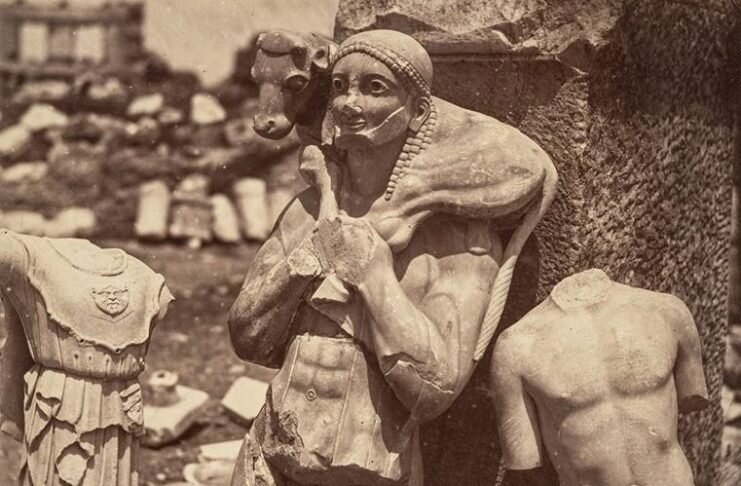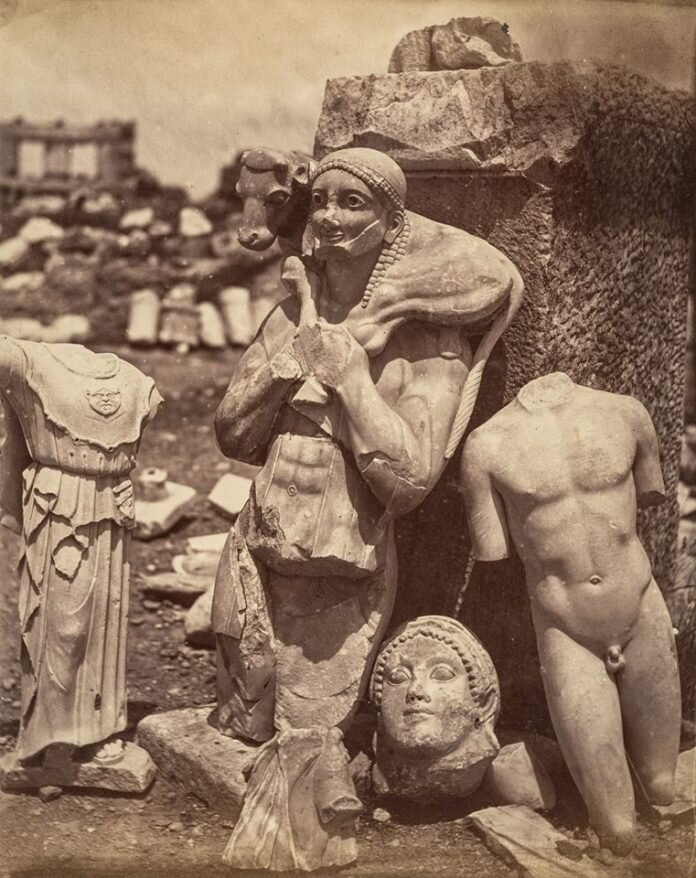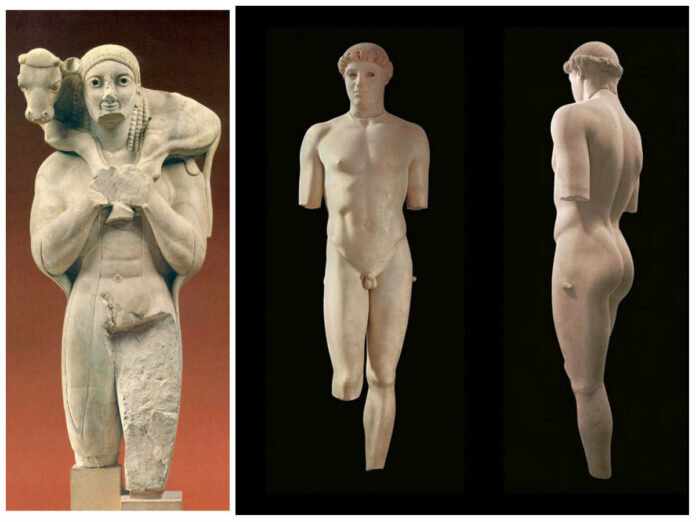This historical photograph records great archaeological finds shortly after their unveiling on the Acropolis. They were buried by the Athenians thousands of years ago to protect them from the Persian threat.

The photographer remains unknown, but the excavation is well known as it took place in the early years of independence after the Turkish rule when important antiquities from the time of classical Athens were excavated from under the Ottoman buildings. In 1863, when it was decided that a museum should be established to safely house the archaeological treasure, more sculptures were found during the excavations for the foundation of the building.
Workers first discovered the headless sculpture of Athena shown on the left of the photo, and in 1864 the calf carrier. Because they did not immediately find the animal’s head, they mistakenly believed that the young Athenian was carrying a goat on his shoulders. Almost a year later, excavations brought to light another masterpiece. Pais of Kritio was initially found headless. The head was later found between the museum and the south wall of the Acropolis and assembled in 1888.

The calf carrier is dated to the 6th century BC, about 560 BC. It is made of Ymittos marble, while the base is made of limestone. It is 1.65 tall and depicts a husky youth carrying a live little calf on his shoulders. He holds the animal’s front legs with his right hand and its hind legs with his left. The statue is smaller than the natural model but gives the impression of a tall, slender young man strong as a bear. He wears a cloak that reaches mid-thigh, covering his shoulders and arms while leaving his chest uncovered in front. His hair is tied high on his head with a ribbon, and the long curls fall down in front of his long and handsome neck. The forehead is flat and vertical, the face cheerful and bright. The calf is calm, full-bodied and lively.

At its base, from right to left, is an engraved inscription: “(Ρ)ΟΜΒΟΣ ΑΝΕΘΕΚΕΝ ΠΑΛΟΥ ΥΙΟΣ”.
“Romvos, the son of Palos” who donated the statue, would be a noble resident of Attica and wealthy enough to pay the master craftsman to build the statue. Apparently, he also sacrificed a calf, perhaps to the goddess Athena, since at that time the main temple was the first temple of Athena on the Acropolis hill, the so-called ancient Parthenon, which was destroyed by the Persian invasion in 480 BC along with all the votive offerings.
Pais of Kritias

Found in 1865 during excavations southeast of the Parthenon. The body was found in a Persian trench where the calf carrier was also buried. It was restored to its present form in 1888 when the head was found between a museum and the south wall of the Acropolis and adapted to the torso by the German archaeologist Professor Adolf Furtwängler. It is a statue made of Paros marble, 117 cm high. From the pigment remains in the hair it was concluded that he was a blond youth. It is likely that he was a young athlete who won a race. His statue was placed in a prominent place on the Acropolis. The body rested on the left leg, while the right took a step forward and bent at the knee. The arms were straight and joined at the thighs. The head has a slight tilt to the right shoulder. Traces of painting are preserved on the body and hair.
Pais of Kritias (right), calf carrier (center) and the headless sculpture of Athena (left) were photographed under the Attic sun. They were buried by the Athenians to protect themselves from the Persians
The calf carrier(left). The body was first found in 1864 and the pedestal in 1887 during excavations on the Acropolis. Next to it was the Pais of Kritias (right). The head was found in 1888 between a museum and the south wall of the Acropolis and was restored to its present form.





